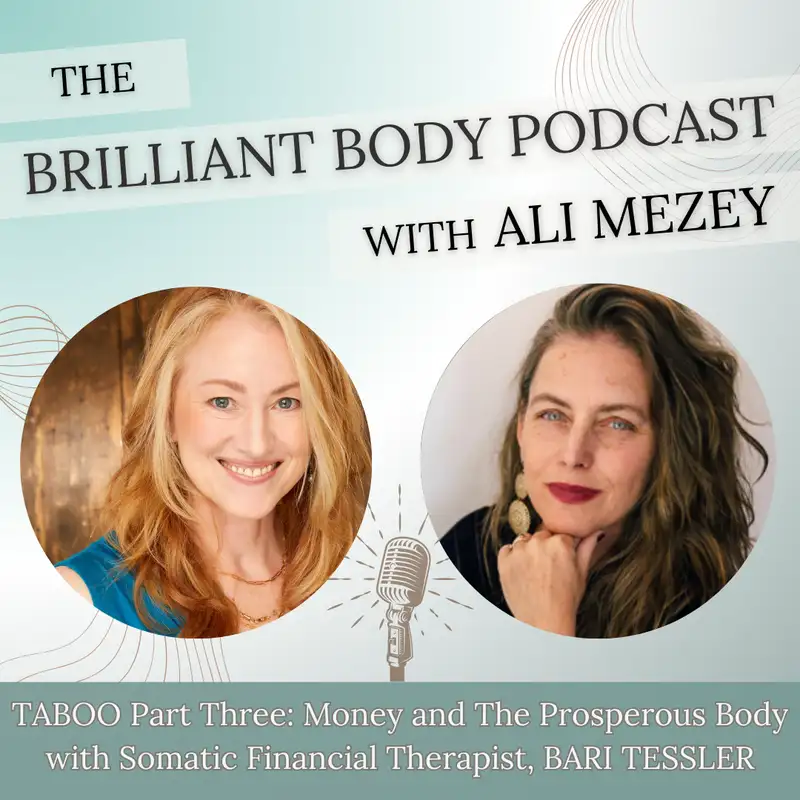TABOO Part Three: Money & The Prosperous Body with Somatic Financial Therapist, BARI TESSLER
SYNOPSIS:
In this episode, Ali Mezey dives into an enlightening conversation with financial therapist Bari Tessler. Bari, a pioneer in the financial therapy field with a master's degree in somatic psychology from Naropa University, shares her unique somatic-based financial therapy methodology. Bari highlights the importance of integrating body awareness with financial literacy and exploring how emotions play a major role in our money decisions. She details the development of her three-phase approach: money healing, money practices, and money maps. The episode is filled with stories and practical tips about body check-ins, overcoming under earning, and learning to have empowered money conversations.
To be an angel to the podcast, click here
In this episode, Ali Mezey dives into an enlightening conversation with financial therapist Bari Tessler. Bari, a pioneer in the financial therapy field with a master's degree in somatic psychology from Naropa University, shares her unique somatic-based financial therapy methodology. Bari highlights the importance of integrating body awareness with financial literacy and exploring how emotions play a major role in our money decisions. She details the development of her three-phase approach: money healing, money practices, and money maps. The episode is filled with stories and practical tips about body check-ins, overcoming under earning, and learning to have empowered money conversations.
To be an angel to the podcast, click here
MORE ALI MEZEY:
Website: www.alimezey.com
Personal Geometry® and the Magic of Mat Work Course information:
Transgenerational Healing Films: www.constellationarts.com
Ali's short description of Constellation Work: https://studio.youtube.com/video/ADAHZWOzRDM/edit
Ali's short description of Constellation Work: https://studio.youtube.com/video/ADAHZWOzRDM/edit
Bio:
Hi, I’m Bari Tessler, a financial therapist and a pioneer in the financial therapy field. I have a Masters degree in Somatic Psychology from Naropa University, 1998, and ran a bookkeeping business for therapists and artists. In 2001, I merged all my training and created a somatic-based Financial Therapy methodology that I’ve been teaching via my Art of Money program and a Mentor Program. I am also the Author of The Art of Money: A Life-Changing Guide to Financial Happiness and The Art of Money Workbook. In my group programs and private financial therapy, I’ve guided thousands of people to bring healing, un-shaming, and empowerment to our money relationships and all that it touches. I live in Boulder, Colorado with my husband, son, many cats + large puppy.
Hi, I’m Bari Tessler, a financial therapist and a pioneer in the financial therapy field. I have a Masters degree in Somatic Psychology from Naropa University, 1998, and ran a bookkeeping business for therapists and artists. In 2001, I merged all my training and created a somatic-based Financial Therapy methodology that I’ve been teaching via my Art of Money program and a Mentor Program. I am also the Author of The Art of Money: A Life-Changing Guide to Financial Happiness and The Art of Money Workbook. In my group programs and private financial therapy, I’ve guided thousands of people to bring healing, un-shaming, and empowerment to our money relationships and all that it touches. I live in Boulder, Colorado with my husband, son, many cats + large puppy.
OTHER RESOURCES, LINKS AND INSPIRATIONS:
Fight, Flight, Freeze and Fawn are common trauma responses that reveal how the nervous system reacts to stress or danger. In this episode, we explore these instinctive behaviors and their impact on emotional regulation, decision-making, and relationships.
The four trauma responses most commonly recognized are:
Fight, Flight, Freeze and Fawn are common trauma responses that reveal how the nervous system reacts to stress or danger. In this episode, we explore these instinctive behaviors and their impact on emotional regulation, decision-making, and relationships.
The four trauma responses most commonly recognized are:
- Fight – when we believe that if we are able to maintain power over the threat, we will gain control. This can look like physical fights, yelling, physical aggression, throwing things, and property destruction. It can also look like balling your hands into fists, feeling a knot in your stomach, crying, being argumentative, or experiencing a tight jaw.
- Flight – when we believe that if we are able to escape the threat and avoid conflict, then we will not be harmed. This can look like running away and avoiding interactions with others," notes Moronu. To avoid uncomfortable feelings, you may escape the situation by staying busy or fleeing for the exit whenever things get tough.
- Freeze – it might look like being at a loss for words, retreating into your mind, having a hard time breaking out and being present, sleeping, dissociating/spacing out, and going emotionally or physically numb.”
- Fawn – people-pleasing and engaging in pacifying behaviors. It's characterized by prioritizing people above all else by doing whatever they want to diffuse conflict and receive their approval. It seems good to be well liked and defer to others to secure safety, but not when it's at the cost of losing yourself. It can reach a point where you abandon yourself and your needs by merging so thoroughly with others.“Fight, Flight, Freeze, Fawn: Examining The 4 Trauma Responses” – Julie Nguyen
Tamara Slayton
Peter Levine
Personal Geometry and Family Constellation Work
The Big Leap by Gay Hendricks
So Barbara Stanny Overcoming Under Earning
Mikelann Valterra
Peter Levine
Personal Geometry and Family Constellation Work
The Big Leap by Gay Hendricks
So Barbara Stanny Overcoming Under Earning
Mikelann Valterra
ENCOURAGE US!: Donate $5
THE WIND BENEATH OUR WINGS. DONATE $25+
Sharing is free! And so is rating us! These are also incredibly helpful ways you can support us in sharing this transformative information.
Thank you, Bari!

